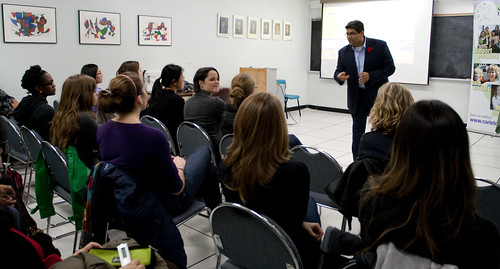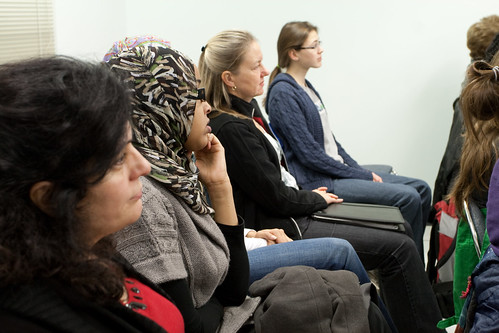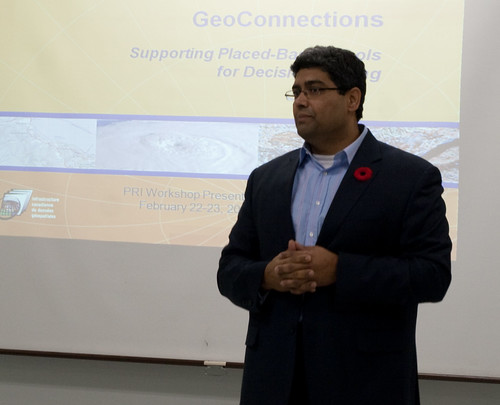Wednesday, December 29, 2010
Google's 2010 in review video
Wednesday, December 22, 2010
Christmas light display & music
Wednesday, December 15, 2010
Malcolm Gladwell on spaghetti sauce and the pursuit of happiness
Tuesday, December 14, 2010
Water Watch
Banu Örmeci is the Canada Research Chair in Wastewater and Public Health Engineering. Together with grad student Natalie Linklater, she’s developing an innovative new monitoring system for water supplies that uses real-time methods to assess change in quality, and achieve rapid screening of water for toxic substances and pathogens.Way to go ladies! Keep up the great work.
Wednesday, December 8, 2010
Science Cheerleaders
The Science Cheerleaders--current and former professional NBA and NFL cheerleaders who are also scientists and engineers--perform LIVE at the U.S.A. Science and Engineering Festival in Washington D.C., October 23-24, 2010. The Science Cheerleaders are now available for appearances! Visit http://www.sciencecheerleader.com for details and to learn more about each of the Science Cheerleaders!
Wednesday, December 1, 2010
National Conference on Women in Engineering
I believe that most of the delegates will agree with me when I say that the highlight of the conference was listening to the experiences of the keynote speakers. Each speaker left a lasting impression through their personal story and words of wisdom. I would like to share some of the key takeaways from the speakers which helped them to become the successful women they are today:
- Recognize opportunities to demonstrate leadership
- Seek out people who think differently than you
- Set a goal – evaluate the tools you will need to attain it
- Be prepared – manage risk, commit, speak with credibility
- Don’t be afraid to change course based on your experiences
- Accept that you cannot control everything
- Be involved in your community
While at the conference, delegates had the opportunity to network with students from other universities from all across Canada (coast to coast!) This was a great way to talk about their respective engineering societies and to share ideas about how to increase the involvement and enrolment of women within engineering.
This conference made me feel very proud to be a woman in engineering. I can say with great certainty that NCWIE brought together future leaders of the engineering community and I am very hopeful for the opportunities which lie ahead for each and every one of these delegates.
Science party tricks!
You might want to check out Prof Wiseman's blog too: http://richardwiseman.wordpress.com
Wednesday, November 24, 2010
Clean the fan
Wednesday, November 17, 2010
Smartphone stunt: random acts of public music
Techcrunch has this great little post, Just Four Dudes Jamming On The Subway — With Their iPhones As Instruments.
You know what I find most astounding about it? Not so much that they're using phones (I've been to multiple concerts which used phones as instruments [1]), but that they conceived this stunt, brought the equipment on a train, and were able to just do this. No one called security, freaking out when they brought speakers on board, even though the person quoted there said that was her first thought.
Here's the video:
Amazing what a real band can do with what's on hand, eh? Now I want to perform random acts of music using all that computing power that fits in my pocket. The phone's a whole lot easier to carry around than my guitar, and a lot easier on my fingertips... Anyone want to work on some tunes?
[1] My personal favourite was Danny Michel at Westfest a few years back. He performs by himself using a loopback device and often doesn't make much deal of it (in fact, I've been with folk who didn't notice) but for one song he laid down the intro using the beeps of an older cell phone, and worked that into the mix that was repeating throughout. It fit incredibly well with the fact that he was singing a song heavy with nostalgia ("In Full Effect").
Thursday, November 11, 2010
Bacteria in a petri dish
The recent (excellent) Green Energy Symposium put together by the Sustainable and Renewable Energy Engineering Society of Carleton University got me wondering about the issue of sustainability. Everyone has heard this buzz word by now. Sustainable energy is generally being taken to mean an environmentally benign renewable energy source capable of satisfying energy demands of the entire world population now and in the future. If you have ever been to any green energy talks you have certainly seen the graph of standard of living vs energy consumption
(The theme of energy conservation always revolves around the need for us to change our mentality and behaviour when it comes to energy use. We have to change the way we think! Communism tried and failed at restructuring the human mind, so why should the sustainable movement succeed?)
Certainly there is some room for power usage improvement, but is Iceland really that energy-greedy or is it just cold? And have we really been getting increasingly power-hungry since the industrial revolution or are there simply more of us now? For some reason no one seems to ever show the population growth data to go with the energy consumption graph. And the world population exploded after world war II just as the power consumption did. Could there be a connection?
 People have certainly gotten crafty at exploiting the Earth to the max, making the most of the available resources such that an ever increasing population can be sustained. Thus if we include solar and wind and biomass into our energy arsenal we are bound to push the envelope even further. But when the population doubles again will that be enough? Ultimately, we are not that different from bacteria in a petri dish. No matter how far we can push our resource envelope, we will eventually hit the resource ceiling and the population will level off in the stationary phase where the birth rate equals the death rate.
People have certainly gotten crafty at exploiting the Earth to the max, making the most of the available resources such that an ever increasing population can be sustained. Thus if we include solar and wind and biomass into our energy arsenal we are bound to push the envelope even further. But when the population doubles again will that be enough? Ultimately, we are not that different from bacteria in a petri dish. No matter how far we can push our resource envelope, we will eventually hit the resource ceiling and the population will level off in the stationary phase where the birth rate equals the death rate.
So perhaps it's not our resource management that's not sustainable. Perhaps it our population growth?
Wednesday, November 10, 2010
Peggy Seeger - I'm gonna be an engineer
When I was a little girl I wished I was a boy
I tagged along behind the gang and wore my corduroys
Everybody said I only did it to annoy
But I was gonna be an engineer
Momma told me, Can't you be a lady
Your duty is to make me the mother of a pearl
Wait until you're older, dear, and maybe
You'll be glad that you're a girl
You can read the rest of the lyrics here if you're curious.
Monday, November 8, 2010
Amazing fuel sources
IEEE spectrum Article
http://spectrum.ieee.org/energy/renewables/betting-on-algal-biofuels/3
The video shows how algae is used to power a toy car.
http://science.discovery.com/videos/invention-nation-algae-biofuel.html
Sunday Times article
http://www.timesonline.co.uk/tol/news/environment/article4133668.ece
Wednesday, November 3, 2010
Miniature kinetic sculptures (small enough to send by post!)
Tuesday, November 2, 2010
CU-WISE talk - Prashant Shukle
More here:
CU-WISE talk - Prashant Shukle













And remember that our flickr group contains photos from previous events! Feel free to contribute your own!
Santa's Dirty Socks
This original story introduces the idea of a divide-and-conquer algorithm using a narrated picture-book verse about the serious problem of finding a pair of dirty socks that have been accidentally wrapped with a child's present. The idea is that this can be played or read to students, and then can be used as the basis for a follow-up discussion. A set of discussion starter questions is available (http://csunplugged.org/divideAndConquer) to encourage students to engage in computational thinking and think about algorithm analysis in the story 1024 presents are searched in 10 steps, and students can be asked to extend this to other cases, and generally think about the implications of having an algorithm with logarithmic complexity.Check out all the videos.
Wednesday, October 27, 2010
Go ENG Girl

This past weekend I had a chance to share my passion for engineering when Go ENG Girl took place at Carleton University on Saturday October 16th. Go ENG Girl is hosted every year at universities across Ontario as an opportunity for girls in Grades 7-10 to learn more about the field of engineering.
The day started off with a welcome and keynote speakers. Students and their parents heard from women studying and practicing engineering and learned more about what it meant to be an engineer. The girls were introduced to the many types of engineering and the opportunities that could arise within the different fields.
While parents heard from a panel of speakers about such things as entrance requirements, academic support, campus life, and career expectations, the students headed off to participate in a hands-on activity.
The grade 7-8 students were given a small design project involving snap circuits. They were asked to create a morse code generator and were then given the freedom to create their own circuits. One group created a lie detector test in which the ‘liar’ would answer a question and then would be required to place their index finger and thumb at a given location on the circuit, which would then detect if they were in fact telling the truth. The detector would hum if they were telling the truth and would make a loud high pitched sound and flash a light if a lie was being told. The circuit detected a ‘lie’ if there was enough moisture on the finger or thumb from nerves and sweat. I have included a picture of this particular circuit. The grade 9-10 students had a chance to use their design solution skills as they were asked to create a catapult which would launch a small mass the greatest distance while having a cost effective design with minimal materials. The projects were presented to the parents and it was clear that there were some future engineers among us!
Students and their parents were given a pizza lunch while being able to browse engineering exhibits and speak with current students. Lunch was followed by an engineering lab tour where some of Carleton’s engineering and research and project labs could be seen.
Go ENG Girl was measured a success when the girls whose parents had ‘forced them to come’ had declared that they would be returning next year and had become interested and excited about engineering. It was very rewarding to volunteer at an event where I could help answer student’s questions and be a representative for my field of study.
I strongly encourage prospective students to seek out opportunities to learn more about their educational interests – it is never too early to start! I also encourage current students to find ways in which to become involved in sharing their experiences and passions – it is never too late to start!
Dot Diva: The Webisode
They've released the first episode of Dot Diva:
KATE, a sarcastic fan of alt- and indie-rock. ALI, a lover of kittens, chick flicks, and the mall. Two girls with NOTHING in common... except for being ace programmers at a seriously-crazy video game company.
As they work to launch Rocklette's first-ever game, these two Dot Divas have to outwit their smarmy boss, Kate's doofus boyfriend, and the spy within their midst.
I wasn't too sure about the first episode initially, since it seemed like they were throwing a lot of the stereotypes in there, but I think they dealt with them ok for a first look, and I expect we'll be seeing more nuanced stuff as the characters develop. I found myself caught up in their story despite my initial feelings of awkwardness. One thing I really loved was how different the two women main characters are, while still both being programmers. What do you think?
Wednesday, October 20, 2010
Mandelbrot Set
Sunday, October 17, 2010
Codeathon for Humanity
I’ve just returned from the Grace Hopper Celebration of Women in Computing (GHC) in Atlanta and had the opportunity to experience my first open source mini-codeathon and learn about the humanitarian open source project, Sahana Eden.Sahana Eden is an open source disaster management platform that can be used in a wide variety of ways to provide organization on the ground in the aftermath of a catastrophe.
Friday, October 15, 2010
GHC10: Open Source Codeathon for Humanity (a blog post in pictures)
There comes a time when you just have to code like a girl:
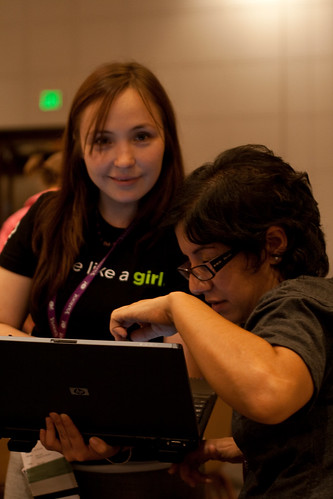
So building on some success last year, we had a codeathon at the Grace Hopper Celebration of Women in Computing. This year, we were working on Sahana Eden, a free and open source disaster management system.

I'm going to admit that the start was a litle rough. Even the mentors found the trainings a bit overwhelming and found that a lot of little issues cropped up when you were setting up your dev environment. One of my "favourites" was an issue where you'd have to run something twice in Eclipse before it would work. There were some perplexed faces!
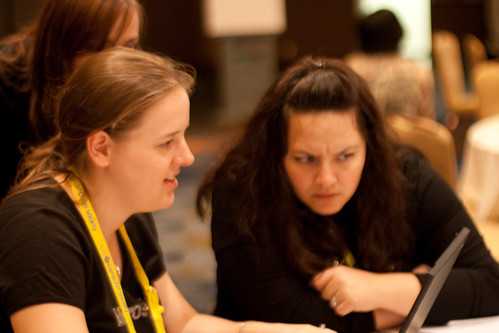
But gradually, people started having success, and having more fun chatting and hacking with the women around them:

It certainly took some work, and some people even came back after the keynotes to keep hacking until late in the night. Fueled with some wine, though, it was pretty fun and I think there was even a patch going in when I stopped by around 11pm. Thanks to everyone who came out and gave it a shot!
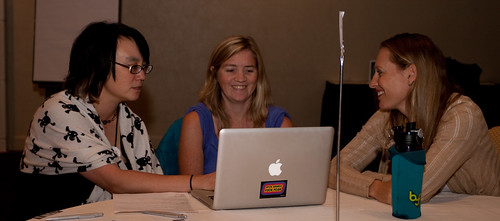
The open source track was graciously sponsored by the NSA, and we'd love to have it again next year, so if you have any comments about how much you enjoyed it, please let us know! You can post here, or Stormy Peters is collecting all the comments together and you can contact her at stormy at gnome.org.

And if you've got suggestions on how we could make the codeathon run more smoothly or things we should do again, we'd love to hear those too! It was very challenging, from getting mentors trained to getting development environments set up through to figuring out what needs doing and how to do it, and I'm sure there are things we can improve upon for next year.
PS - You can see more of my GHC10 photos, including more from the codeathon here, and don't forget to check out our GHC10 flickr group and the professional event photos
GHC10: PhD Forum 3: UI/Education
As always, I've got to say that it's a real breath of fresh air to hear people talk about their research at GHC. Often times, I dread grad student presentations (despite being a grad student myself!) because the quality of presentation isn't polished... but this is totally not the case at GHC. These women are enthusiastic, interesting, and great communicators and it's been a joy to attend these sessions. So here's the three women whose talks I caught today. (My apologies for the poor quality of the pictures: the room was quite dark and I was too busy listening to focus on photography!)

Usable Security in Practice: Collaborative Management of Electronic & Physical Personal Information
Presenter: Laurian C. Vega (Virginia Polytecnial Institute)
Security literature likes to imply that humans are the weak link in the security chain, but that's not actually true: much of the problem is that security work doesn't take the human into account when designing systems, so we wind up having to do things just that don't make sense. I sort of take this as a given, since it's a common theme within my own security group and our larger research network, but it's sometimes a hard sell in the larger security community.
So I was really thrilled to see Laurian's presentation about how she's investigated taking the human into account in security research for electronic health records. She points out that we need to go beyond focusing on getting medical folk to adopt them, figuring out their workflow, etc. and understand the entire environment in which a system is used, particularly when considering records in medicine.
Laurian's been doing active observation at childcare centres and physician's offices, specifically in rural southwest-virginia. Because she was working with rural sites, she's found a lot of the records are non-electronic, which in some ways can make things more secure: physical records can be hidden behind someone's desk, files can be hidden in the back, cabinets can be closed. One problem she found in childcare and physician's offices is there are quite a lot of interruptions, and many people do not return to the task when they're interrupted. Laurian's looking at ways to design systems which can handle this sort of interruption, as well as other realities of what goes on in the offices. This is pretty neat and not much like traditional security work, which assumes a user who's paying attention and will always do all the right steps. It sounds like some really fascinating work to deal with some very specific challenges!
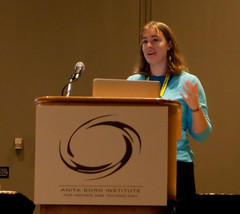
In the Beginning: The Early Lives of Users in Online Communities
Presenter: Katherine Panciera (University of Minnesota)
From the title, I was expecting a more broad look at various online communities, but Katherine's work actually focusses on wiki contributions, specifically a site called Cyclopath where users can contribute cycling route information, including the roads to follow and details about what to expect along the way. The idea was to see how the top 5% of users ("cyclopaths") differed from other users, and how cylopath users in general differed from users of Wikipedia.
It turns out that you can actually determine which users will become cylopaths from day one: they start off by making many more edits than more casual users (50ish versus 5ish), and like Wikipedia users it turns out that people start high and then slowly tail off to a stable editing pattern. But what was even more interesting about Katherine's research is that you could see patterns in the future cyclopath uers use of the site even before they started editing.
I can only imagine how helpful it might be to be able to identify your top users and perhaps encourage them right from the beginning so they feel even more at home in the community. Very neat!
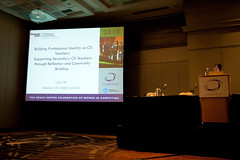
Building Professional Identity as Computer Science Teachers: Supporting Secondary Computer Science Teachers through Reflection and Community Building
Presenter: Lijun Ni (Georgia Institute of Technology)
Lijun says she got interested in computer science teachers because there are very few of them at the K-12 level, so there's a great need to prepare and support the teacher. She's focused on two problems: it's very difficult to retain teachers (46% will leave teaching within 5 years, and math and science are worse than some other subjects) and teachers have some resistance to change (many in-service teachers will not adopt curriculum innovations). It's also surprisingly difficult for CS teachers to develop a sense of identity as a CS teacher, since there's inconsistent certification, it's hard to fit them into the school hierarchy, they have few peers, etc.
What I really thought was interesting about Lijun's work is that she's working on finding ways to support teachers over the course of their carrers, giving them opportunities to learn and grow and develop an identity as a CS teacher. She's looked at how their identities change over time to see how to better support them. This is really interesting because most effort thus far has been in training them to start rather than retaining people with very little focus on retention.
It got me thinking that this is something you also see as a problem when talking about women in computer science: there's lots of programs for younger girls who want to get involved, but fewer programs in place to help keep women from leaving in disgust. I wonder if Lijun would be interested in tackling that problem next?
Wednesday, October 13, 2010
Dolphins blowing bubble rings
Observing animal behaviours is an important part of biology, but a part that maybe doesn't have as long a history as one might think: one of my relatives told a tale of how birdwatchers used to shoot the birds and identify them later, rather than the more modern (and humane!) way of trying to identify them on the wing. I've met naturalists who hope we'll see a switch to observing bugs the way we do birds. And Jane Goodall, when she was visiting Ottawa for the Writer's Festival, talked about how when she recorded her observations of chimpanzees many people told her that she was being foolish to ascribe emotions to them when trying to explain their behaviour!
So here's the video some dolphins who've learned a neat trick and seem to be having fun with it. What animals have you observed lately?
Tuesday, October 12, 2010
Quick hit: Women = Men when it comes to math skills
Females Are Equal to Males in Math Skills, Large Study Shows
These studies, all published in English between 1990 and 2007, looked at people from grade school to college and beyond. A second portion of the new study examined the results of several large, long-term scientific studies, including the National Assessment of Educational Progress.
In both cases, Hyde says, the difference between the two sexes was so close as to be meaningless.
But despite these findings, we still may be a ways away from the day when I can quit doing back of the napkin demonstrations about gender and math ability:
The idea that both genders have equal math abilities is widely accepted among social scientists, Hyde adds, but word has been slow to reach teachers and parents, who can play a negative role by guiding girls away from math-heavy sciences and engineering. "One reason I am still spending time on this is because parents and teachers continue to hold stereotypes that boys are better in math, and that can have a tremendous impact on individual girls who are told to stay away from engineering or the physical sciences because 'Girls can't do the math.'"
(Read the rest of the article here.)
Monday, October 11, 2010
Geocaching in Atlanta Part 2
While we were completing the USAA geocaching challenge, we found a real geocache. We found 'Arms Wide Open'. It was Shruti who spotted the cache under the statue's shoe. It was definitely a clever hide. Later in the day, I had some time to myself and decided to find 'Shining Light #2'. The cache page explains that a shining light award is given each year to recognize "a Georgian who has been an inspiration to the lives of others through service to humanity. A gas lamp and plaque is installed in their honor at a site of their choice." This cache was a nano cache. This is the smallest kind of cache container. The cache has a magnet on it and it was placed on one of the screws on the back of the plaque so it looks like it belongs there.
October 1st was a busy day for me so I only had a chance to look for a cache right before heading over to Sponsor Night at the Georgia Aquarium. Just before heading out to look for a cache I ran into Terri and she was interested in helping me look. We headed to 'Allons-y Alonso' which I wanted to do because of its French name. We ended spending several minutes looking in some trees without having any luck. It finally occured to me that it might be a lamp post skirt cache. This is a cache that is hidden near the bottom of a lamp post. You need to lift the 'skirt', a metal piece near the bottom of a lamp post, in order to find the cache. That's exactly where it was. We had to be discreet since there were a couple of cab drivers parked close by.
I decided that on October 2nd, our last full day in Atlanta, I would geocache for most of the day. I made a plan with my husband, Tom, to complete the 'Downtown U Web Cam Cache'. A webcam cache requires to you to have your picture taken by a webcam. They usually suggest that once you are at the spot, to call a friend with your cellphone and have them save a picture on their computer. I do not own a cellphone so Tom and I made a plan for me to be at the location from 11:00am to 11:05am. It all worked out and Tom was able to get a picture of me in from the webcam. Next, I walked to the state capitol to attempt '23 Karat Dome'. Unfortunately, there were too many people around and I wasn't able to find this one without being spotted.
After lunch I completed 'Reading Rainbow Cache'. This one, like 'Quilt of Nations', was a multi. The first stage took me to a statue and I had to count the number of books in it. After a few calculations with this number, I had the coordinates for the final. This took me to the Atlanta-Fulton County Library. In order to find the exact location, I had to some research on the internet. I had to find four numbers and do some more calculations to get another number. This number turned out to be a Dewey decimal classification number. So I made my way to the books with this number and started looking for the cache. I had done a similar cache in Montreal a couple of years ago where the cache was in the book "Geocaching for Dummies". This time the cache wasn't in a book but stuck using a magnet to the bottom of a shelf.
The next cache I attempted was 'Gone With The Wind'. It took me to the cemetery where Margaret Mitchell, the author of Gone With The Wind, was buried. This cemetery, the Oakland Cemetery, is one of the oldest cemeteries in Atlanta. Unfortunately, I was unable to find this cache. The cemetery also has two virtual caches here which I found. The first virtual cache I found was a monument to the Confederate dead that was dedicated April 26th, 1894. It is called 'The Lyin' Cache'. After collecting some information from the monument and a headstone of confederate soldier, I was on my way to the other virtual cache in the cemetery called 'The Master'. This brought me to the headstone of Bobby Jones, one of golf's greatest players. To complete this cache, I had to collect some information from one of the headstone's close to Bobby Jones'. Once I got back to my hotel later that day, I emailed the cache owners the information and was them able to log my finds.
Later that day, Gail, Terri, Shruti and I wanted to try out The Varsity and there happened to be some caches on the way there. We ended up not finding two of them but we did find the one at The Varsity called 'What'll Ya Have?'. It was another lamp post skirt cache. On the cache page, it recommended trying the chilidogs, onion rings, glorified steaks and frosted orange drinks. Since I wasn't all that hungry, I tried the onion rings and a frosted orange. I always love places like this because they do fast food the way I imagine it used to be done and their portion sizes aren't ridiculously huge.
On Sunday October 3rd, I only had time to find one cache. Gail, Terri, Shruti and I headed back to one of the caches we couldn't find the night before called 'Atlas Shrugged'. It's a statue of Atlas holding an advertisement. During our initial search we didn't have the hint (it was "Do you really kneed one?"). This made all the difference and we easily found it this time. Also during our initial search for this cache, a guy in his car stopped at the light asked "Are you geocaching?". I guess four girls frisking a statue isn't very subtle.
Before putting 'Atlas Shrugged' back, I grabbed a travel bug from the cache. A travel bug is an item that is moved from cache to cache which is logged each time it is moved. The travel bug I took from 'Atlas Shrugged' is called Maori Ducky and is trying to get to the South Island of New Zealand. This is a map of its travels to date.
During my 6 day stay in Atlanta, I managed to find 13 geocaches. Not a huge amount but not bad considering how busy I was with the conference and that I mainly got around Atlanta by walking. A lot of these caches took me to places I never would have known about and made sightseeing more interesting.
Sunday, October 10, 2010
Developing Skills to Enhance Group Intelligence and Productivity
Meritocracy? Might want to re-think how you define merit.

You might think if you put together a lot of smart people, you'd get a smart group, but new research into group intelligence shows that's not always the case. (For those of you who don't have access to online journal subscriptions through your local library or university, there are more details in the Carnegie Mellon University press release.)
What we found is that the intelligence of the team members was not significantly related to the collective intelligence, either positively or negatively.
[...]
Our first observation and the one that surprised us the most was that the proportion of females in the group seemed to be strongly predictive of the collective intelligence of the group.
However, when they looked more closely they realised that it wasn't the gender that mattered, but rather the social sensitivity of the group members (previous studies had shown that women tend to score more highly in social sensitivity).
It's not the intelligence of the group members that matters; it's their social sensitivity.
So the more your group members were socially sensitive, the better the group performed in measures of collective intelligence. The key here was that group members need to collaborate, and to do that they needed those social skills to help them work together. This includes some different conversational patterns: groups where one or two people dominated conversations exhibited low collective intelligence, while groups where more people contributed had higher collective intelligence.
This scientific research is potentially a big blow to the standard "meritocracy works" theory often espoused in open source and computing groups. Standard meritocracy rules say you do clever things and you get accepted, and this will make for perfectly good teams. But given that there's often bias that dismisses "soft skills," it turns out that folk may actually be using typical geek meritocracy rules to weed out some of the people we need to make the group most effective as a whole.
Some of my female colleagues would like to conclude that you simply just need to hire more women. While that might be easier, what it really suggests is that you need to pay attention to what people refer to as these "softer skills" and thinking about who's going to be a good team player, not necessarily focused solely on individual achievement, individual accomplishments.
So if you want to claim that the best way to build tech teams is meritocracy... you might want to think more carefully about how you define merit.
The quotes in this article are drawn from Bob McDonald's conversation with Dr. Anita Williams Woolley, the lead author, on the Quirks and Quarks interview aired October 9. You can download the podcast of the segment on collective intelligence here.
Saturday, October 9, 2010
The DaRosa lab is competing in "Dance your PhD"
The dreaded question. "So, what's your Ph.D. research about?" You could bore them with an explanation. Or you could dance.
That's the idea behind "Dance Your Ph.D." Over the past 3 years, scientists from around the world have teamed up to create dance videos based on their graduate research.
Check out their dance, which teaches you about Maureen McKeague's work on "Selection of a DNA aptamer for homocysteine using systematic evolution of ligands by exponential enrichment." (Long name, but it's a fun and innovative way to explain some chemistry!)
Selection of a DNA aptamer for homocysteine using SELEX from Maureen McKeague on Vimeo.
McKeague's Ph.D. dance, based on her research at Carleton University in Ottawa, Canada, is about a technique called Systematic Evolution of Ligands by Exponential Enrichment (SELEX). The target is a small molecule called homocysteine. SELEX uses natural selection to find the small strands of DNA called aptamers (the other dancers) that bind specifically to the target. Watch for the hilarious Taq Polymerase scene in the middle of the dance.
And when you're done watching, you can check out the other entrants and vote for your favourite (we hope it'll be chemistry!) on the sciencemag website. The results will be announced on October 19th.
Friday, October 8, 2010
Career and Economic Opportunity in Open Source Software
Thursday, October 7, 2010
GHC10: HCI Track at Grace Hopper
The Grace Hopper Celebration of Women in Computing had two special technical tracks added to the program this year: open source and human-computer interaction. While I was definitely happy to see the open source track, it was the HCI talks that really got me excited. I'm just getting into HCI myself, choosing it as one of my topics for my PhD comprehensive exams and submitting my first CHI paper. There was so much to learn from a variety of great speakers!Read the rest of my post here.
Wednesday, October 6, 2010
Enzyme, what you doing today? (GTCA)
Tuesday, October 5, 2010
Overcome Personal Barrier - Duy-Loan Le
Read more on ABI's Wiki
http://community.anitaborg.org/wiki/index.php/Keynote:_Duy-Loan_Le_%28Texas_Instruments%29
Pyramids, Not Ladders - Carol Bartz
The Power of Abstraction and The Barriers Women Could Have - Barbara Liskov
In her interview with Silicon.com, Barbara mentioned the barriers women could have:
Exactly what the barriers are--people have theories about this (but) they don't totally understand it. I think a lot of it has to do with our societies. It's probably strongly related to other things we see going on like the fact that women are not well represented...in the top maths. If you look at, for example, who's doing well in the maths contests that happen internationally you'll see that women are underrepresented there.
I don't believe any of this has to do with basic abilities but I do think it has a lot to do with the way that our society is--what we think is appropriate for women to do (and) what we think is appropriate for men to do. I do think it's mostly a problem before they get to college--if they get to college and they still are open-minded enough to be interested and they didn't cut themselves off by taking the necessary science and math ahead of time then I think at least they aren't going to hit the glass ceiling until they get quite far along.
About Barbara Liskov, you can read more on MIT EECS website.The hotel we stayed


Mentoring, Encouraging and Celebrating at GHC 2010
Finally I arrived in Atlanta with four other Carleton students under the support of WISE . They are Gail and Terri from Computer Science, Bridget from Mathematics and Shruti who is my roommate from Innovation in Technology. The weather coordinated perfect in Atlanta for the conference, sunny and the temperature was always in the middle of twenties. And we couldn’t wait for the conference.
It turned out a great surprise to me and at the same time full of joy. I have never seen so many technical women (about 2100 people) coming to conference together in my whole life. Because I am an electrical engineer, every time I went to conferences I was always the minority. Although I never feel awkward in those circumstances, I still feel the big difference when so many women get together, talking about their ups and downs, mentoring and encouraging each other, and at the same time celebrating. Just like the keynote speaker Duy-Loan Le mentioned in her witty talk – now it is the time to let those men to feel what it is like when they are surrounded by so many women.
Before we came to the conference, the conference committee sent out a newsletter asking all the participants to introduce themselves to people sit around them and make new friends. So the overall atmosphere during the conference was very positive. Participants introduce themselves by either shaking hands or exchanging the Poken, which is pretty cool. Company staff standing besides their booth would tell you that they really, really want to meet with you, which made all the people laugh.
Every day I was very busy running between different sessions and the most important, never missed a keynote speech and plenary panel. Those women are all excellent role models and at the same time good speakers. Some of them are very straightforward and witty, others are deliberate and full of wisdom. But all of them showed us how wonderful their lives are, how proud they feel as the leaders in their own fields, and how grateful they are to their mentors and families. Many of the award winners were talking in tears especially those from academia. Then I saw a different picture in these amazing women, as intelligent and strong as men, as delicate and sensitive as ordinary human being. Gender is not an issue anymore in these occasions, instead I saw those beautiful minds coming across long journeys and sharing their struggles and happiness at the podium.
GHC10: NCWIT at Grace Hopper: Recruiting and Retaining Women
From the Communications of ACM blog:
Research scientists Lecia Barker and Joanne Cohoon from the National Center for Women & Information Technology (NCWIT) gave an excellent talk on recruiting and retaining women in computer science at the Grace Hopper Celebration of Women in Computing. I almost didn’t attend because I’ve been immersed in these topics through my involvement with Carleton University’s Women in Science and Engineering group (known here as CU-WISE), but I found that I still learned a lot. I highly recommend taking a look at their website after reading my summary of the talk.Read the rest of my post here.
Friday, October 1, 2010
GHC10: Dancing with Hundreds of Technical Women at Grace Hopper
From the Communications of ACM blog:
When I tell someone about the Grace Hopper Celebration of Women in Computing, I start by explaining the dance parties. I tell them, “You wouldn’t think that an all-female dance would be fun… but you’d be wrong. There’s nothing like dancing with hundreds of technical women who let loose because there’s nobody around to feel stupid in front of.”Read the rest here.
Geocaching in Atlanta Part 1
 I guess any blog post about geocaching should start with an explanation of what it is. It's basically a high tech treasure or scavenger hunt. You log onto geocaching.com, do a search of a location you want to geocache in, put the coordinates on a GPS and then go find the cache. A cache is a container that contains at least a log book that you sign once you find it. It can also contain trade items. These are items that you can take if you leave something else in the cache.
I guess any blog post about geocaching should start with an explanation of what it is. It's basically a high tech treasure or scavenger hunt. You log onto geocaching.com, do a search of a location you want to geocache in, put the coordinates on a GPS and then go find the cache. A cache is a container that contains at least a log book that you sign once you find it. It can also contain trade items. These are items that you can take if you leave something else in the cache.I got into geocaching a few years ago when visiting my friend Dave (whose geocaching name is Juicepig). He had been doing it for a couple of years and was very passionate about it. The first cacheI ever found was at an abandoned campsite in Utopia, Ontario. It was interesting to visit and we would never have gone there if it wasn't for this geocache. This is one of the great things about geocaching in a city you are visiting; it takes you to places you never would have known about. That was one of the reasons I decided to geocache in Atlanta while attending the Grace Hopper Celebration of Women in Computing. The other reason is that before I left for Atlanta, I had found at least one cache each day for the last 58 days and wanted to keep up my streak.
I also wanted to find two caches that were really far apart on the same day. So on Monday September 27th, before leaving for Atlanta, I found 'OLYMPIQUES 3 - TIGRES 2' near the Robert Guertin arena in Gatineau, Quebec and once in Atlanta, I found 'Birds Eye View' with Terri and Gail. The distance between these two caches is about 1500 km (900 mi). The 'Birds Eye View' cache was magnetic and stuck on a pole that had to road signs on it.
On Tuesday September 28th, Gail, Terri and I spent the day at the Atlanta History Center (you can read about it here) so I didn't end up caching until after 5pm. Gail and I decided to find a cache before heading over to the Hyatt to pick up our badge and swag for Grace Hopper. We attempted 'Folk Art Park Part 2' but couldn't find it. We moved onto 'Folk Art Park Part 1' and found it without any trouble. Both of these caches brought us to two interesting parks with Folk Art.
On Wednesday September 29th, I went to Centennial Olympic park and started working on finding 'Quilt of Nations'. This cache is what is called a multi cache. It takes you to several locations and often you have to collect some information at each spot in order to find the next stage of the cache. The first stage took me to a 'quilt of nations'. I had to count the number of flags, add it to a particular number and that would complete the missing portion of a coordinate. I did this and went on to the next stage.
This stage was at a building that used to be a church but is now a music hall. I had to find the three numbers to the left of the box office and add them to a number and this gave me the missing portion of the coordinate for the final. I made my way to the final but there were two police officers nearby so I moved on to another cache called 'Shining Light' which was at one of the entrances of Centennial Olympic Park. Its container is the smallest kind of container in geocaching. It is called a nano and I'll talk more about this type of container in my next post.
After finding that one, I headed back to the final for 'Quilt of Nations' and easily found it. One of the hints on the cache page told you to remember the numbers from the music hall. I needed it in order to open the combination lock on the cache. The final for this cache was a gray plastic container attached to a telephone poll. It is out in the open but unless you were looking for the cache you would never give it a second look.
In 'Geocaching in Atlanta Part 2', I'll talk about the rest of the geocaches I found in Atlanta as well as explain what a travel bug is.

